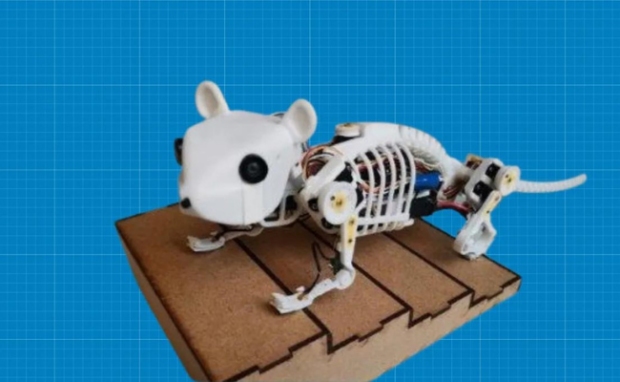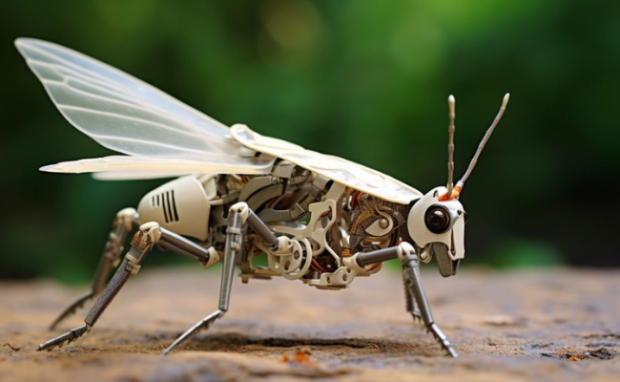Researchers made flexible robot spine
Scientists have created a robotic spine that enables their four-legged robot to move like a mouse. They called the machine robot NeRmo, which can scurry, balance, and turn with agility. As a result, the flexible robot spine could expand the capabilities of four-legged bots.
When they hear about robotics, most may think of two-legged robots like Tesla’s Optimus bot. However, we’ve been making smaller, quadrupedal bots for other functions. For example, Japan created a cockroach robot that facilitates rescuing people after disasters. That machine spine could enable scientists to build similar bots with different functions.
This article will discuss how the flexible robot spine works. Later, I will cover other similar innovations for minuscule robots to illustrate robot development further.
How does the robot spine work?

Researchers created a robotic mouse called NeRmo with a specialized spine to replicate the shape and motion of a real-life mouse. Zhenshan Bing from the University of Zurich and his colleagues created it to improve a quadrupedal robot’s capabilities.
The spine improved its walking speed, turning behavior, and static stability. That component uses a tendon-pulley system that emulates muscle contraction with eight ball-and-socket joints.
NeRmo also has knee and elbow joints that emulate a rodent’s musculoskeletal anatomy. The experiment showed that NeRmo could increase its static stability by adjusting its posture with its robot spine.
They demonstrated that the spine could extend the stride length of a gate to boost its walking speed. Also, they showed NeRmo could perform agile maneuvers that require both a small turning radius and fast walking speeds.
You may also like: Scientists create muscles for robots
The researchers also explained why a flexible spine replicating the biological counterpart could boost the performance of legged robots. Interesting Engineering said we’ve made legged robots that can walk on stairs, tunnels, and wildlands.
They can perform limited dynamic behaviors relying only on their legs. However, a functional spine could help smaller robots, especially four-legged ones, move better.
The scientists said the robot could improve by making the spine and tail more limber. Also, they could add more complex neural controllers for adaptive motion partners. NeRmo could also inspire new applications in education, entertainment, exploration, and search and rescue.
Other robotics innovations

University of Zurich researchers created a robotic spine, and the University of Illinois developed insect-like robots. It can leap 60 times higher than their body size.
Sameh Tawfick, the associate professor at the University of Illinois’ Department of Mechanical Science and Engineering, said they gave “the robot planned mobility, where it can now jump from A to B, traversing terrain rougher than its own size.”
They created a monolithic elastomeric robot design inspired by a locust’s leaping motion using projection additive printing and coiled artificial muscle actuators. The group used a four-bar linkage design for leaping inspired by the locust.
The animal’s four legs are not linked, but the scientists’ robot relies on one muscle as a linkage system. Tawfick’s prototype has a lightweight elastomer body and an artificial muscle from a heat-treated nylon fishing line. He and his colleagues tested 108 robot iterations.
You may also like: Robotic hands have realistic bones, ligaments, and tendons
The smallest one’s mass was 0.216 grams, and it could jump 60 times its body size at a horizontal distance. The Mechanical Science & Engineering webpage said developing this insect-sized robot is useful for agricultural and maintenance applications.
Tawfick’s prototype has a lightweight elastomer body and an artificial muscle from a heat-treated nylon fishing line. He and his colleagues tested 108 robot iterations.
The smallest one’s mass was 0.216 grams, and it could jump 60 times its body size at a horizontal distance. The Mechanical Science & Engineering webpage said developing this insect-sized robot is useful for agricultural and maintenance applications.
Conclusion
Researchers created a flexible spine for their mouse-like robot. As a result, NeRmo demonstrated how it could improve movement for quadrupedal bots.
However, they admitted that the machine has many points for improvement. For example, they could improve their AI to make them more adaptable.
Learn more about the robot spine research on the ScienceRobotics webpage. Moreover, check out the latest digital tips and trends at Inquirer Tech.